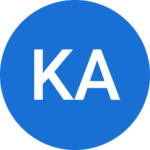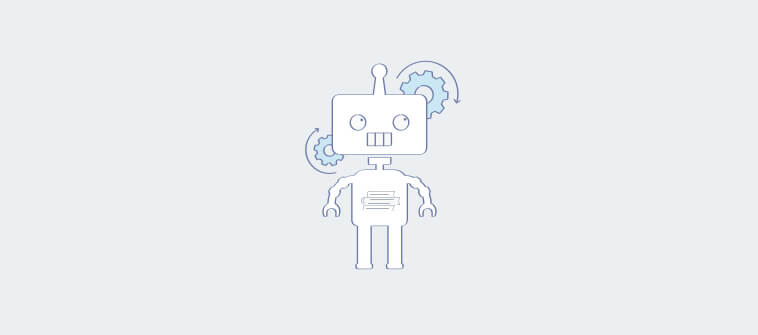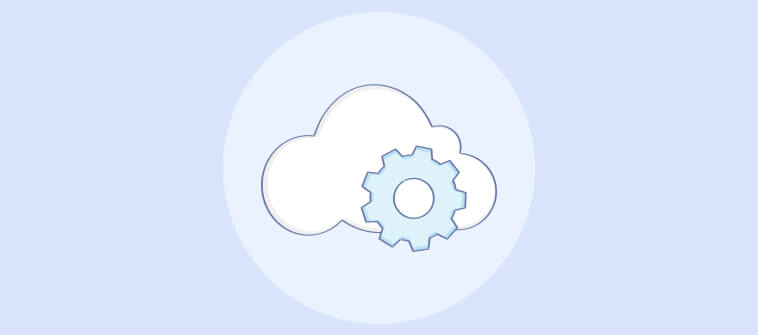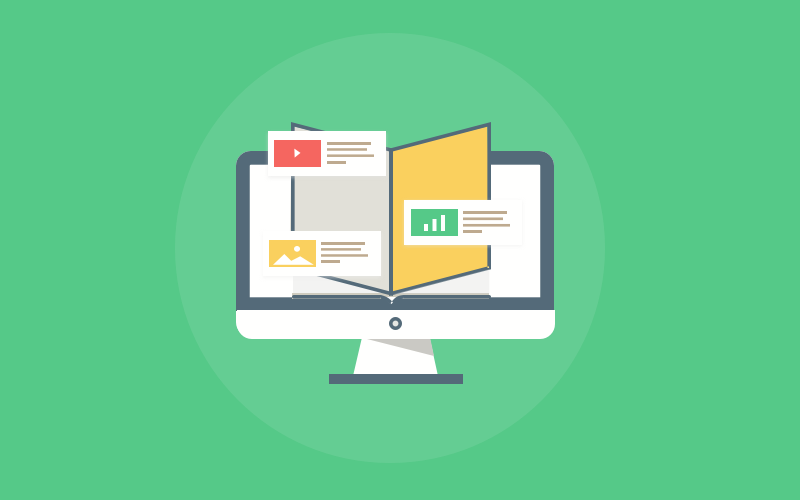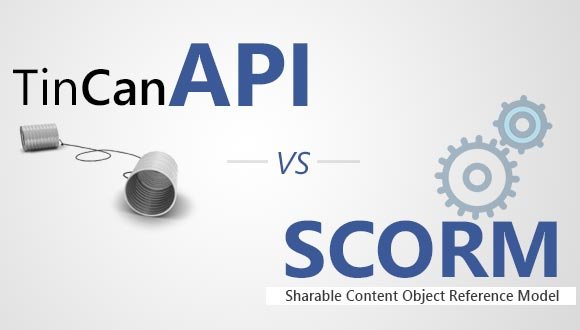Companies are pouring over $280 billion a year into corporate learning. Yet many still struggle to track whether their training is actually working.
That’s where learning record stores (LRS) come in.
If you’re serious about eLearning, you need to understand LRS technology. It’s the missing link that helps organizations measure training effectiveness, track learner progress, and make data-driven decisions to improve ROI.
I’ve spent over a decade in the eLearning space, and I can confidently say that LRS is a paradigm shifter. But here’s the challenge—not all LRS platforms are created equal.
Some offer powerful analytics, while others focus on integrations, usability, security, or scalability. The right choice depends on your specific needs.
That’s why I’ve put together this guide on the best learning record stores to help you pick the right one. Here’s what you’ll learn:
✅ What an LRS is (and why it’s crucial for modern eLearning)
✅ How an LRS works behind the scenes
✅ Key features & benefits that set top LRS platforms apart
✅ The difference between an LRS and an LMS (because they’re not the same!)
✅ A breakdown of the best LRS software available today
✅ How to choose the right LRS for your organization
Let’s find the best LRS to maximize your training ROI.
A Quick Comparison Table
| Learning Record Store | Best For | Pricing | |||||
|---|---|---|---|---|---|---|---|
| ProProfs Training Maker | Employee training | Forever free for small teams. Paid plan starts at $1.99/learner/month for large teams. | |||||
| Veracity Learning | Educational institutions | Free (100 MB storage limit). Paid plans start at $100/month. | |||||
| Instancy | Blended learning | Starts at $2/user/month | 10 Best Learning Record Stores (LRS) in 2025 | ||||
| Xyleme | Content management | Custom pricing | |||||
| Sponge | Collaborative learning | Custom pricing | |||||
| Valamis | Large enterprises | Starts at €12,000/year | |||||
| Learning Locker | Data-driven organizations | Starts at $115/month | |||||
| Watershed | Modern enterprises | Free (limited reporting capabilities). Paid plans start at $4,083/month. | |||||
| Rustici | Third-party integrations | Starts at $48,231 for 500 users | |||||
| OnPoint Digital | Mobile and offline learning | Starts at $9500 |
What Is a Learning Record Store?
A learning record store is a repository of learning data that records learning events in a ‘noun, verb, object’ format, such as: ‘Peter completed an onboarding course. It follows the xAPI specification, which is a standard for tracking learning activities on and off an LMS. An LRS is the core of any xAPI ecosystem and can store and access learning records from an LMS or another LRS.
Numerous organizations rely on LRS to improve their training programs. It has become the mainstay of effective training, better employee performance, and business growth based on learning data.
LRS is used across various industries to track and analyze learning experiences. For example, in healthcare, LRS monitors staff training on new procedures or equipment to ensure compliance and competency.
Similarly, in manufacturing, they can track employee progress in safety training or technical skills development and identify areas for improvement and reduce workplace accidents. Likewise, in the field of education, LRS tracks student engagement and performance across different learning platforms, besides providing insights into individual learning paths and enabling personalized learning experiences.
How Does an LRS Work?
An LRS lies at the center of a learning ecosystem and gathers data from all the learning systems, apps, and content.
Here’s how it works in an employee training system:
- As soon as an xAPI-enabled software experiences learning activities, it sends activity streams to an LRS where they are recorded as xAPI statements.
- Using an xAPI-compliant LMS, another LRS, or a reporting tool, you can easily access the data stored in the LRS.
- You can store data in an xAPI learning record store as discrete learning records or bulks of transcripts.
- You can configure the learner record system to provide users access to the stored data.
What Are the Key Features of a Learning Record Store?
The main features of an LRS are as follows:
- xAPI Compatibility: Supports the Experience API (xAPI) for tracking and storing learning activities.
- Centralized Data Repository: Collects data from various learning sources (eLearning, simulations, mobile apps).
- Real-Time Analytics: Provides insights into learner performance and engagement.
- Data Interoperability: Open architecture for integration with other systems like learning management systems (LMS) for seamless data exchange.
- Scalability: Handles large volumes of learning data across organizations.
- Compliance and Security: Ensures data privacy and meets regulatory standards.
- Customization: Offers configurable reporting and analytics for tailored insights.
What Are the Benefits of an LRS?
An LRS brings the following benefits to the table:
- Better Data Collection: An LRS can help you capture different kinds of data comprising formal and informal learning experiences from inside and outside a learning environment.
- Flexibility: It’s intuitive and flexible enough to function as a standalone system or within an LMS platform.
- Wide Applications: You can use learning record store software across different industries, including education and businesses, via various platforms that speak the same language.
- Real-Time Assistance: Learners, instructors, admins, and teachers can access learning data in real-time, regardless of time and place.
- Improved Learning: Learning based on data interoperability adds more value through a deeper understanding of learners’ experiences and needs. You can access, view, and act on the aggregate data collected from different systems.
Get Free eLearning Authoring Software — All Features, Forever.
We've helped 567 companies train 200,000+ employees. Create courses in under a minute with our AI LMS or use 200+ ready-made courses on compliance, harassment, DEI, onboarding, and more!
List of the Top Learning Record Store Software
1. ProProfs Training Maker
ProProfs Training Maker is a cloud LMS that comes with a built-in LRS. Whatever training you deploy, you can bring in all your data under a single roof from other eLearning platforms and store it in the LMS. It combines tools for creating, delivering, and tracking all learning activities.
I am fascinated by how it tracks and reports learners’ activities throughout all training programs. The ability to import data as zip files from other LMS, portals, and mobile devices further enhances the system’s value. I can record interactions and view reports as Tin Can statements. I can also check the test scores and whether my learners have read a PDF, watched a video, or clicked on an image.
As an LRS plus LMS, ProProfs Training Maker enables you to create courses and assessments, and once your learners take them, you can view the reports in the LRS. So, it’s an all-in-one solution that will help you fulfill all your eLearning needs.
Key Features
- Tracking Learner Progress: It captures data on quiz scores, course completion, and time spent learning.
- Generating Reports: The LMS generates reports on learner performance and provides insights into individual and overall training effectiveness.
- Data Export: You can export data in the form of CSV, PDF, and Excel to potentially use the data in other systems.
- Activity Completion Records: It records when learners complete specific activities within a course and gives a trail of learning events.
- User Management & Grouping: The LMS supports user management and grouping for segmenting learning data and analyzing it based on different learner demographics or teams.
Pros
- User-friendly interface and simple setup process.
- Statistics for in-depth performance analysis.
- Real-time data access, management, and reporting
- Course authoring tool, a virtual classroom environment, and a library of ready-to-use courses.
Cons
- Dark and light mode options can be added to improve user experience.
- The free plan doesn’t come with dedicated support, unlike the paid.
Pricing
There’s a forever free plan perfect for small teams, while paid plans start at just $1.99 per active learner per month. You also get a 15-day money-back guarantee to test the waters. The Business Plan, at $3.99 per active learner per month, unlocks advanced perks like unlimited sub-groups, detailed analytics, and custom integrations. The Enterprise Plan kicks off at $499 per year for larger businesses with zero hidden fees.
User Rating
Best For
Employee Training
2. Veracity Learning
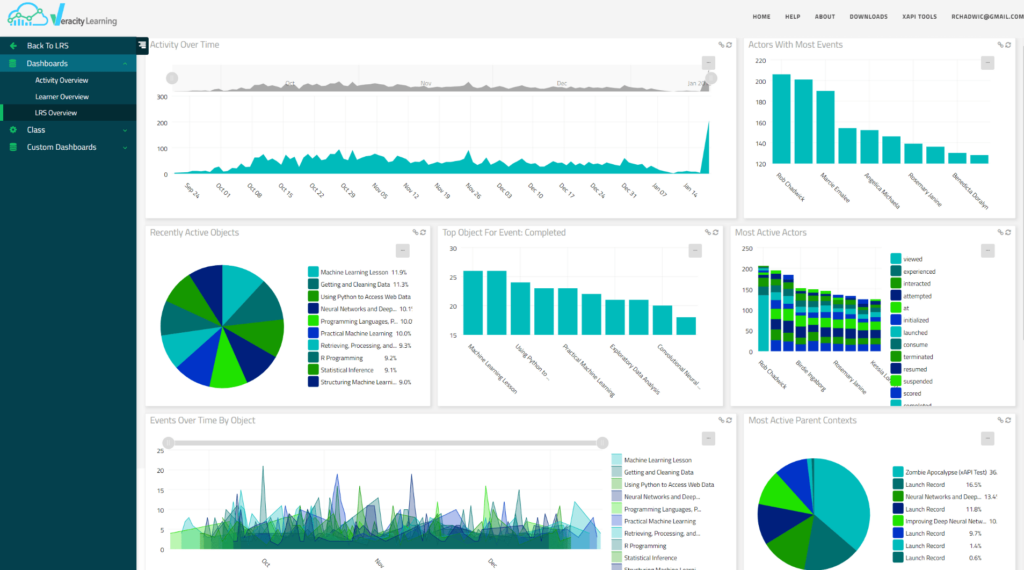
Veracity Learning is a versatile and robust learning record store (LRS) that can store and retrieve xAPI statements from various sources and platforms. It can handle different types of xAPI data, such as attachments, signatures, and documents.
It also allows you to import and export data to and from other LRSs. You can use Veracity Learning LRS in different ways, depending on your needs and preferences. You can install it on your own server, host it on the cloud, customize it with your own branding, or use it as a lightweight version.
Thanks to its compatibility and interoperability features, you can also exchange data with other LRSs seamlessly.
Veracity Learning LRS can even integrate with offline education, meaning that it can capture data from real-world learning activities, such as field trips, experiments, presentations, and assessments.
This can help educational institutions measure the impact of their education programs on students’ performance and outcomes in a comprehensive way.
Key Features
- xAPI Conformance: Fully supports the Experience API (xAPI) for collection and storage of diverse learning activities.
- Advanced Analytics & Dashboards: Provides robust graphing and reporting tools, including a chart builder and advanced query capabilities.
- Plug-in Architecture: Features a unique plug-in system that allows users to create custom integrations, extend functionality, and enhance the user interface.
- Content Hosting & Management: Supports content hosting with xAPI Launch capabilities, and includes tools for managing users, classes, and courses.
- Scalability and Flexibility: Designed to handle large volumes of data, Veracity Learning can scale to meet organizational needs and offers both cloud-hosted and on-premises deployment options. citeturn0search11
Pros
- Veracity Learning is an official xAPI-conformant LRS that fully supports all types of xAPI data, including statement signatures, binary attachments, and document stores.
- It has robust analytics and multiple dashboard interfaces for learners and instructors, with special support for common xAPI profiles such as SCORM.
- You can create custom dashboards and embed reports in other applications.
- You can create and manage courses, classes, and users within the platform.
Cons
- It doesn’t offer all the features and functionalities of a full-fledged LMS, such as grading, assessment, feedback, etc.
- It’s not very user-friendly or intuitive for beginners or non-technical users.
Pricing
Free (100 MB storage limit). Paid plans start at $100/month.
User Rating
4.5
Best for
Educational Institutions
3. Instancy
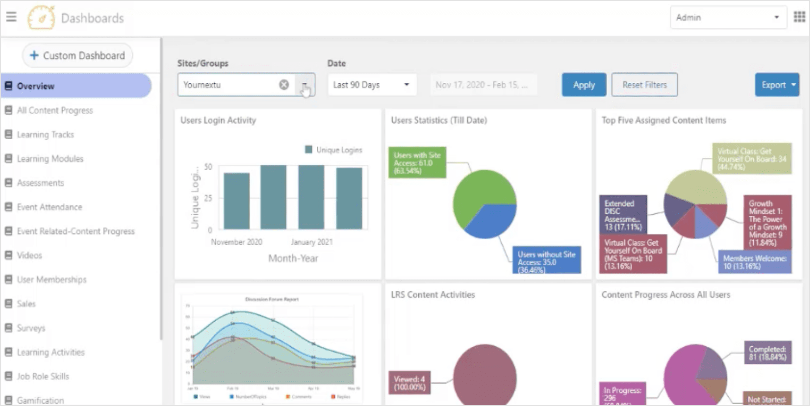
Instancy is more than just a learner record store. It is a complete learning ecosystem that allows you to track and store all the learning experiences of your learners, whether they occur inside or outside your learning management system (LMS).
With Instancy, you can store all the learners’ activities and progress in one central location and access them anytime, anywhere. You can also enhance the quality of learning by delivering engaging and personalized content on various platforms, such as mobile devices, web apps, or other external systems.
Instancy is the best LRS for blended learning because it offers a comprehensive solution that integrates with a total learning ecosystem. It automates the learning workflow by assigning the next course modules, recommending the best learning paths, and providing feedback and support.
It also adds gamification and multimedia elements to make the learning experience more fun and interactive. Moreover, it supports eLearning standards and data interoperability using xAPI, enabling seamless communication between content and learners’ progress reports.
Key Features
- AI-Powered Personalization: AI-driven learning pathways and performance support through personalized content and tools.
- Content Management & Authoring Tools: Includes a comprehensive suite for eLearning content creation, including AR and VR editors.
- Mobile & Multi-Channel Learning: Delivers learning via mobile apps, websites, and chatbots.
- LRS: Supports xAPI and LRS integration for tracking and analyzing learning data.
- Third-Party Integrations: Seamless integration with enterprise applications, CRM systems, and web conferencing tools.
Pros
- Instancy integrates with various platforms and systems, allowing you to track and store your learners’ learning experiences in one central location.
- It automates learning workflow and provides feedback, saving time and effort for both learners and instructors and enhancing the learning outcomes.
- Adds gamification and multimedia elements, increasing learner engagement and motivation and improving retention and recall.
- Supports eLearning standards and data interoperability, enabling seamless communication between content and learners’ progress reports.
Cons
- Requires internet connection and xAPI compatibility
- Some users have reported privacy and security issues.
- May be costly and complex to implement for small organizations
Pricing
Starts at $2/user/month
User Rating
Best for
Blended Learning
4. Xyleme
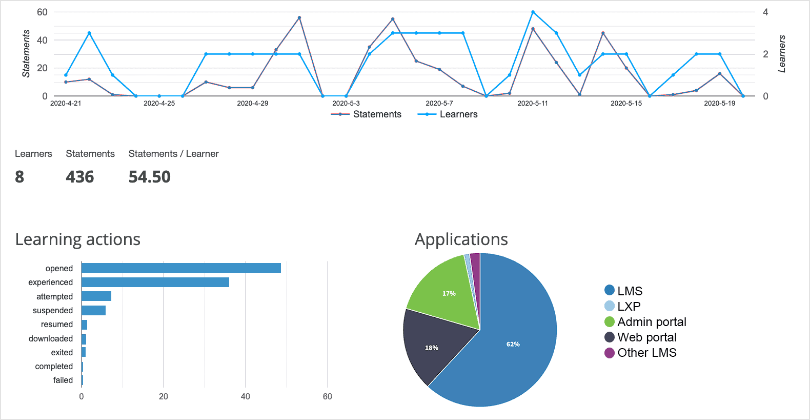
Xyleme is an xAPI LRS that collects detailed content engagement and learner performance data. This data helps organizations to evaluate their training programs and identify knowledge gaps.
Based on the data analysis, organizations can make necessary improvements in their training programs to enhance learning and engagement.
Xyleme is also ideal for content management, as it provides robust analytics and dynamic dashboards to identify trends and areas for improvement and seamless integration with external business tools and applications.
This LRS software has a powerful dashboard that offers more than just pass-and-fail metrics. The dynamic dashboards allow you to analyze content and monitor user trends. The xAPI integration enables the smooth transfer of data and gives a holistic view of how learners have interacted with your content.
The enterprise-level security features, such as Single Sign-On (SSO) and regulatory compliance support, make it one of the best LRS systems on the market.
Key Features
- AI-Assisted Content Authoring: Streamlines content creation with AI-powered suggestions and automation.
- Content Syndication: Distributes content across various platforms and channels, both internal and external.
- Centralized Content Management: Provides a single repository for all learning materials, simplifying organization and updates.
- Multi-Format Delivery: Enables content creation and delivery in diverse formats to suit different learning needs.
- Seamless Integrations: Connects with other learning systems for a unified learning ecosystem.
Pros
- Collects detailed data to evaluate training programs and identify knowledge gaps.
- Provides robust analytics and dynamic dashboards to optimize content and delivery methods.
- Integrates seamlessly with external business tools and applications to support diverse learning ecosystems.
- Offers enterprise-level security features, such as SSO and regulatory compliance support, ensuring data protection and privacy.
Cons
- Requires technical expertise to set up and manage
- May not be compatible with older or legacy systems
- May be expensive for small or medium-sized organizations
Pricing
Custom pricing
User Rating
Best for
Content Management
5. Sponge Learning
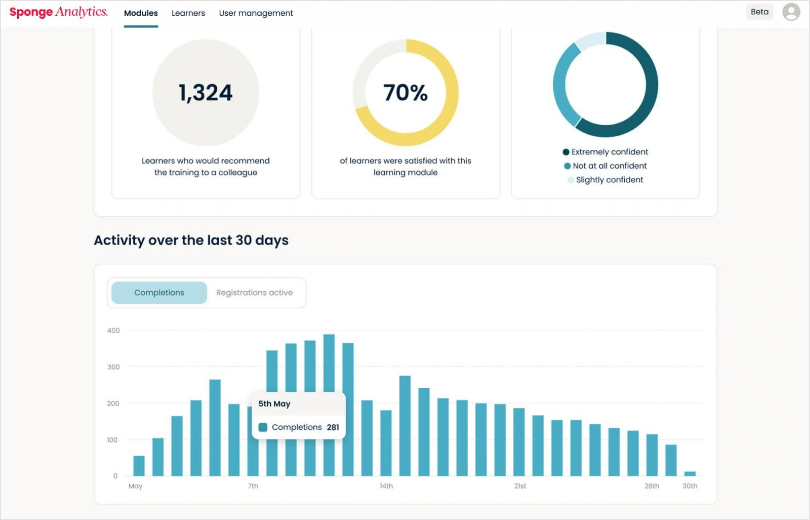
Sponge Learning is a powerful system that tracks and stores all your learning and business data. It is integrated with Spark LMS, a popular software used by leading companies like PayPal and IKEA.
Sponge helps you create training programs for your employees and teams, and monitor their learning experiences and outcomes. You can track their progress with various types of content, such as desktop, mobile, games, or simulations.
You can also launch content outside your LMS and get insights into how your learners interact with it.
Sponge LRS also supports collaborative learning and fosters social skills, problem-solving, and critical thinking. It allows you to track and measure the collaboration among your learners, such as how they share feedback, exchange ideas, and co-create content.
You can also create personalized learning paths for each learner based on their preferences, goals, and performance.
Key Features
- Bespoke Digital Learning: Custom-designed learning experiences tailored to align with company branding and objectives.
- Experience Design: Uses learning science and strategic goals to design impactful learning solutions.
- Blended and Facilitated Learning: Combines online and offline learning for a more engaging and holistic approach.
- Creative Studio: High-quality storytelling and multimedia design for engaging eLearning content.
- Learning Strategy Consulting: Provides expert guidance for global learning strategy and consulting services.
Pros
- Sponge works seamlessly with Spark LMS, a trusted and widely used software for managing learning.
- It keeps track of and stores all your data related to learning and business in a safe and easy way.
- Gives you insights into how your learners interact with and engage with content outside your LMS.
- Measures how learners collaborate with each other, such as giving feedback, exchanging ideas, and creating content together.
Cons
- Some users complained that the LRS is not compatible with some content formats or platforms, such as SCORM, Moodle, or Adobe Captivate.
- The interface is a bit confusing, and the documentation is not up to the mark.
Pricing
Custom pricing
User Rating
Best for
Collaborative Learning
6. Valamis
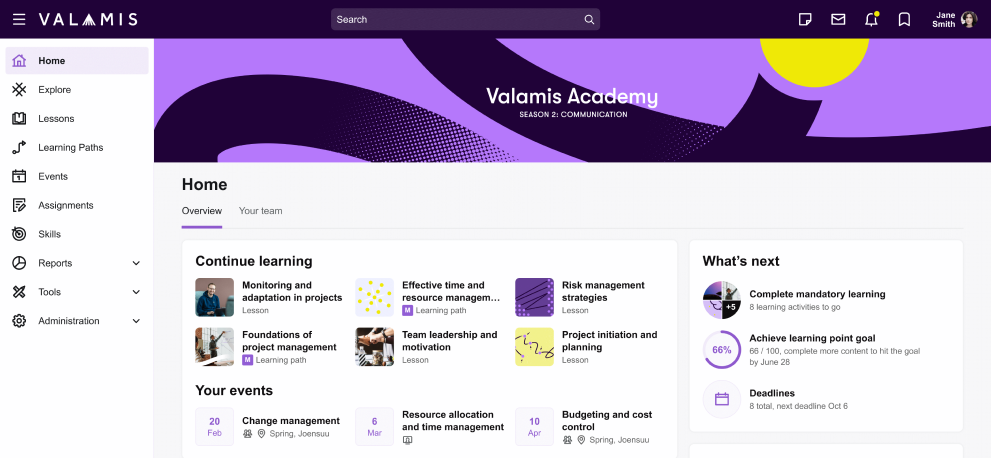
If you’re a large enterprise, Valamis is an amazing option for you. It offers a user-friendly and flexible platform that supports both xAPI and SCORM standards.
You can use Valamis to collect and store data from various online and offline learning experiences, such as e-learning courses, webinars, simulations, games, VR/AR, and more.
You can also convert SCORM packages into xAPI statements to track and aggregate learning data easily.
Valamis is capable of streaming and handling a large amount of data without losing any of it, thanks to the Kafka stream processing software. It also ensures high performance and scalability, as it can handle big data, fast and in real-time, and adjust to your needs and traffic.
With Valamis, you can access insightful metrics that help you identify the gaps between learning, performance, and business outcomes. You can also get personalized learning recommendations, compliance tracking, and effectiveness measurement.
Valamis is built and managed by data experts who ensure the security, reliability, and quality of the LRS.
Key Features
- LRS Integration: Valamis integrates with various LRS solutions to leverage the benefits of an LRS without building it from scratch.
- xAPI Support: It supports the xAPI standard for compatibility with a wide range of learning technologies.
- Data Collection & Storage: Collect and store learning data from various sources, including LMS, simulations, and mobile apps.
- Analytics & Reporting: Valamis offers robust analytics and reporting tools to analyze learning data, identify trends, and measure effectiveness.
- Integrations: It integrates seamlessly with other enterprise systems, such as HR and ERP.
Pros
- Valamis is a complete learning solution that includes a learning experience platform (LXP), a content authoring tool, and an analytics dashboard.
- It is a robust and scalable platform that can handle large amounts of data and traffic.
- Modern and intuitive user interface that makes it easy to navigate and use the LRS
- Social learning features that enable you to collaborate and communicate with learners and instructors
Cons
- Valamis requires a lot of customization to fit specific needs and may not work well with existing systems.
- It is expensive compared to other LRSs.
Pricing
Starts at €12,000/year
User Rating
Best for
Large Enterprises
7. Learning Locker
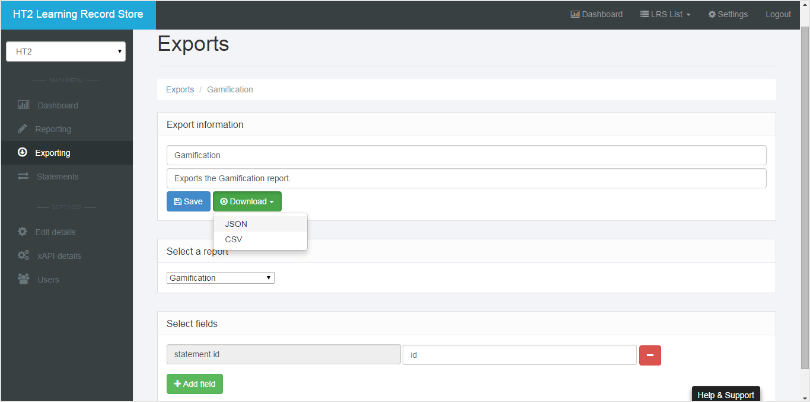
Learning Locker by Learning Pool is the best LRS system for data-driven organizations that want to record and collect vast learning data from multiple sources. The platform offers great visual insights in the form of graphics, diagrams, and charts to help you better understand and analyze your aggregated data.
It’s 100% compliant with xAPI and ready to deliver the results that today’s organizations need. The modern UI and backend ensure that all data is more tactile, accessible, and useful than before.
You can use XAPI as the central storage point and gather learning data from internal and external sources, such as Moodle, Canvas, Slack, Salesforce, and more. Learning Locker offers numerous integrations, giving you more flexibility and convenience in managing your learning data.
You can also leverage the best-in-class automation features, such as workflows, triggers, and actions, to streamline your processes and enhance your learning experience.
Learning Locker supports flexible deployment as it supports enterprise and open-source options, allowing you to scale up or down as per your needs.
Key Features
- xAPI Compliant: Supports the xAPI standard for capturing of a wide range of learning experiences from various sources.
- Centralized Data Storage: Provides a single repository for all learning data and simplifies access and analysis.
- Data Visualization & Reporting: Tools to visualize learning data and generate reports that provide insights into learner progress and program effectiveness.
- Integrations: Integrates with other learning platforms and systems for a connected learning ecosystem.
- Scalability and Security: Designed to handle large volumes of data and ensures data security and privacy.
Pros
- Learning Locker lets you store and access a lot of learning data from various sources
- You can see your data in a visual way with graphs, charts, and diagrams.
- You can automate your processes and enhance your learning experience with features like workflows, triggers, and actions.
- You can get support from a friendly and knowledgeable team of experts.
Cons
- Online documentation is not clear when it comes to creating queries.
- Requires some technical knowledge to set up and configure.
Pricing
Starts at $115/month
User Rating
Best for
Data-Driven Organizations
8. Watershed
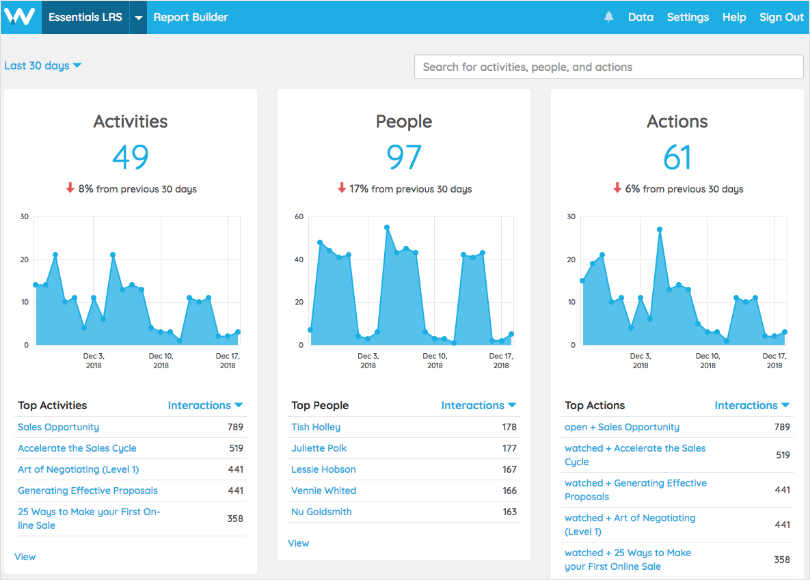
Watershed lets you easily track and explore learning outside of an LMS. It’s a great choice for xAPI enthusiasts, L&D practitioners, and modern enterprises. At least, that’s what my impression was after I took a demo with the LRS.
It allows you to integrate data from multiple sources and platforms, such as webinars, surveys, assessments, and social media.
You can also create custom dashboards and visualizations to monitor and improve your learning outcomes. This LRS xAPI conformant software enables developers to perform data search, data stats and debugging.
For L&D practitioners, this tool can help track learning activities through robust reports, which lay the foundation for effective learning and training analysis. This LRS serves as a record system where you can accumulate all the data for your learning programs.
Using it you can measure the impact of your programs and maintain all learning records as xAPI statements. The best part about this software is that you can store all the data as xAPI statements, even if it was delivered through a non-xAPI source.
Key Features
- Learning Data Aggregation: Collects data from various learning and performance systems using xAPI and proprietary connectors.
- Advanced Learning Analytics: Provides detailed insights with robust reporting on learning programs, including custom dashboards.
- Customizable Reporting: Allows users to automate, customize, and share reports across teams or embed them in other systems.
- Integration With Learning Ecosystem: Integrates seamlessly with multiple learning platforms to unify learning data.
- Scalability & Security: Designed to handle large data sets and meet enterprise-level integration and security requirements.
Pros
- An intuitive report explorer that allows users to create and explore beautiful reports.
- Handy features like customizable templates, dashboard, and snapshot sharing.
- Real-time aggregation of data from various sources
- It provides a comprehensive learner transcript that shows each learner’s activities across the entire ecosystem.
- It is an open learning analytics platform that allows users to integrate with other tools and systems.
Cons
- Not enough pre-built visualization formats or formatting capabilities.
- It requires some technical skills and knowledge to set up and use.
Pricing
Free (limited reporting capabilities). Paid plans start at $4,083/month.
User Rating
Best for
Modern Enterprises
9. Rustici
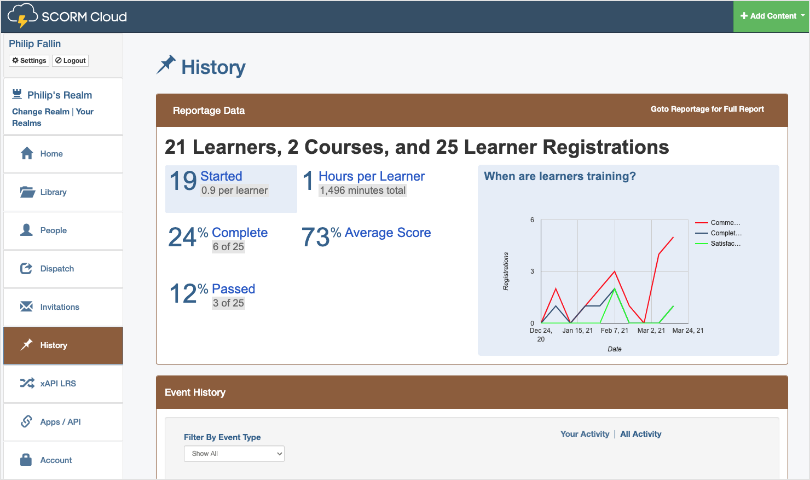
Rustici is an LRS that supports the ADL xAPI standard and it can seamlessly integrate with various learning systems and platforms. What I find truly fascinating about it is that it lets users choose which xAPI statements they want to store and which they don’t, and manage multiple tenants within one database.
You can also use Rustici to exchange reports and data with other LMS and LRSs, and trigger actions based on xAPI statements. The LRS also allows you to create, distribute, and monitor training programs using any e-learning standard, such as SCORM, cmi5, AICC, or PENS.
Rustici is a great LRS for third-party integrations because it offers content connectors, which are ready-made plugins that make it easy to search and import content from third-party libraries directly into Rustici Engine.
This way, you can access a wide range of learning content from different sources and track the results using the same APIs as other Rustici Engine courses.
However, Rustici is not a complete LMS solution, so if you need more features and functionalities for your learning needs, you might want to consider other options. But if you already have an LMS and want to leverage the power of xAPI and third-party content, then Rustici is an excellent choice.
Key Features
- ADL Conformance: Fully adheres to the xAPI standard and is regularly updated to ensure conformance with the evolving xAPI specification.
- Multi-Tenant Databases: Allows setting up both shared and individual databases for different tenants, catering to diverse organizational needs.
- Statement Control: Offers the ability to intercept and reject xAPI statements, ensuring streamlined reporting and content guidelines enforcement.
- Statement Forwarding: Facilitates connection to other LRSs to enable the forwarding of data and consolidation of learning reports from various sources.
- Event Triggers: Configures triggers based on incoming xAPI statements for programmatic actions based on predefined conditions.
Pros
- Rustici LRS is ADL-conformant and ensures compliance with the xAPI standard.
- It supports multi-tenant databases and allows you to set up different configurations for each tenant.
- It lets you trigger events based on statements received and programmatically respond to incoming data.
- It has a delightful support team, developers and xAPI experts who provide assistance throughout the integration process and ongoing maintenance.
- Rustici LRS is updated as the xAPI standard evolves, so you never have to worry about keeping up with the changes.
Cons
- Rustici LRS is not an all-in-one tool that combines an LMS and an LRS, so you need to integrate it with your existing learning platform or application.
- It’s also not a learning analytics platform that provides advanced reporting and visualization of the xAPI data, so you need to use another tool like Watershed for that purpose.
Pricing
Starts at $48,231 for 500 users
User Rating
Not found
Best for
Third-Party Integrations
10. OnPoint Digital
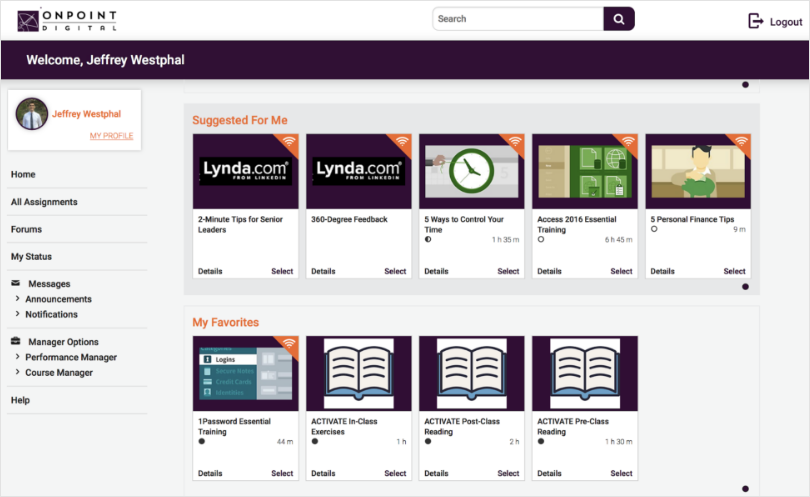
OnPoint Digital LRS is a cutting-edge software that combines the best of both worlds: LMS and xAPI. It is designed to support mobile and offline learning, as well as social and informal learning.
It allows learners to access content anytime, anywhere, and on any device. Whether they are online or offline, learners can sync their data with the LRS and continue their learning journey seamlessly.
With OnPoint Digital LRS, you can track and analyze not only the content progress and assessment results of your learners, but also their UX navigation patterns, social interactions, and other learning activities.
OnPoint Digital LRS also provides you with powerful dashboards and analytics tools that enable you to measure the effectiveness of your training programs and the performance of your learners. It’s the ultimate solution for learning in the digital age.
Key Features
- xAPI Conformance: Fully integrated with xAPI for comprehensive tracking of both formal and informal learning activities.
- Advanced Analytics & Dashboards: Provides a variety of dashboards and data analytics tools to define xAPI statements for any system action.
- Offline Tracking: Offers full “offline xAPI” statement tracking for mobile users that ensures data collection even without an internet connection.
- Integration Capabilities: Includes API connectors to connect to other LRSs, such as Watershed, to facilitate seamless data exchange across platforms.
- Customizable User Experience: Features a customizable user interface (UI) and user experience (UX) to tailor the learning environment to specific needs.
Pros
- OnPoint Digital LRS allows customization of UX/UI and mobile app for both iOS and Android devices with online or download play capabilities.
- It supports installs with hundreds of users in one location to 250K+ learners across the globe.
- It offers specialized solutions for various use cases and industries on a project/short or program/long-term basis.
- It delivers end-to-end learning experiences with the help of mobile, social/game-enabled, AI/ML-driven, and xAPI-extended learning solutions.
- It enables you to check, manage, and create insightful reports from the data collected by xAPI statements.
Cons
- Some users have reported technical issues or bugs that affect the performance of the system.
- It may have some compatibility issues with certain browsers or devices.
Pricing
Starts at $9500
User Rating
Best for
Mobile & Offline Learning
Learning Record Store vs LMS: What Is the Difference?
The following comparison table lists the major differences between an LMS and an LRS:
| Criteria | Learning Management System | Learning Record Store |
| Purpose | Manages and delivers online courses and assessments. | Stores, reports, and transfers learning data using xAPI. |
| Primary Function | Create, manage, share, track, and analyze learning content. | Collects and stores data on learning activities. |
| Data Standard | Typically tracks formal learning activities within the system. | Uses xAPI to track formal and informal learning activities. |
| Integration | Can work with LRS to enhance learning tracking. | Can integrate with LMS for advanced analytics or work independently. |
| Flexibility | Primarily focused on delivering structured learning programs. | Offers more control over learning data from various sources and systems. |
| Granularity of Data | Tracks formal learning data (e.g., courses, tests). | Provides detailed and granular data on informal learning activities. |
How to Choose the Right LRS for Your Organization
While choosing an LRS, make sure you consider key factors such as functionality, scalability, security, reliability, and system integrations. Look for a vendor that provides a conformant LRS since they are put through rigorous testing. This way, you can rest assured that your LRS follows the latest xAPI specifications.
To know how to pick an LMS that supports LRS, watch this video:
Here’s how the Right LRS can help you-
Case Study: How YUM! Brands Utilized LRS to Understand Its Store Performance
Background: YUM! Brands, one of the world’s largest restaurant companies with over 41,000 outlets in more than 125 countries, sought to improve its employee training programs. The company wanted to understand how its training initiatives impacted store performance. It also wanted to gain deeper insights into employee learning behaviors.
Challenge: YUM! Brands lacked the technology to fully explore their learning data. It was difficult to determine if employee training influenced store performance. They needed a solution to capture and analyze learning activities across various platforms and correlate this data with business outcomes.
Solution: The company implemented an LMS’ learning record store to collect and analyze learning data. It integrated xAPI to track employee interactions with training materials and combined this data with store performance metrics. This integration gave a comprehensive analysis of how learning activities influenced business outcomes.
Implementation:
- Data Integration: YUM! Brands integrated data from multiple sources, including employee training materials and store performance metrics, into the LRS.
- Real-Time Tracking: Utilized xAPI to capture real-time data on employee interactions with training content.
- Reporting & Analysis: Developed reports to compare training engagement with store performance metrics and establish correlations between learning activities and business outcomes.
Results:
- Enhanced Insights: Gained a deeper understanding of how employee training impacted store performance.
- Data-Driven Decisions: Enabled the learning team to make informed decisions about training programs based on data analysis.
- Improved Training Programs: Identified areas for improvement in training content and delivery methods.
By implementing an LRS, YUM! Brands transformed its approach to learning analytics. The ability to track and analyze learning activities in detail enabled the company to link training efforts directly to business performance. This led to more effective and impactful training programs.
Get Free eLearning Authoring Software — All Features, Forever.
We've helped 567 companies train 200,000+ employees. Create courses in under a minute with our AI LMS or use 200+ ready-made courses on compliance, harassment, DEI, onboarding, and more!
Choose the Best Learning Record Store Platform
The right learning record store software can help you achieve your training goals and maximize your ROI. But to find it, you have to take into account various factors, such as ease of use, functionality, security, scalability, integrations, and more.
ProProfs Training Maker is one such platform that ticks all the boxes. It comes with a built-in cloud LRS. It allows you to create and deliver engaging courses, quizzes, surveys, and assessments. The LMS supports xAPI and SCORM standards, and lets you track learner progress and performance with AI reports. It also offers expert-taught ready-touse and customizable courses for compliance and skill training.
You can get started with its free plan to test the water and upgrade to a higher plan later on.
Remember, an LRS centralizes data from various online learning activities and lets you conduct a comprehensive tracking and analysis of learner progress. This, in turn, helps you gain deeper insights into learning effectiveness and personalize training experiences based on detailed performance data. Start leveraging this technology if you’ve not already and see the difference.
Frequently Asked Questions
Is it difficult to implement an LRS?
The implementing part can vary in complexity, depending on your organization’s needs, the tools you’re integrating, and the existing infrastructure. For some, it can be straightforward, especially with pre-built solutions, but for others, custom configurations might require additional time and expertise.
Are there free LRS options available?
Yes, there are free learning record store vendors, though they might offer limited features or require manual setup. Examples include learning record stores like Learning Locker or Tin Can API-based solutions like ProProfs Training Maker.
Can I use an LRS without an LMS?
Yes, an LRS can operate independently without an LMS. It tracks learning activities and stores data, which can be useful for analytics and reporting, even without a connected learning management system.
Can an LRS integrate with other tools and systems?
Yes, an LRS is designed to integrate with many other tools and systems, such as LMS, authoring tools, HR systems, and analytics platforms, for seamless data exchange and enhanced reporting capabilities.
What are some common challenges when using an LRS?
Common challenges include data quality management, integration with other systems, ensuring consistency across multiple platforms, and understanding the technical aspects of XAPI (Experience API) and its setup.
 Tips
Tips
We’d love to hear your tips & suggestions on this article!
Get Free eLearning Authoring Software — All Features, Forever.
We've helped 567 companies train 200,000+ employees. Create courses in under a minute with our AI LMS or use 200+ ready-made courses on compliance, harassment, DEI, onboarding, and more!
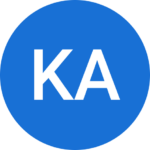
 We'd love your feedback!
We'd love your feedback! Thanks for your feedback!
Thanks for your feedback!

